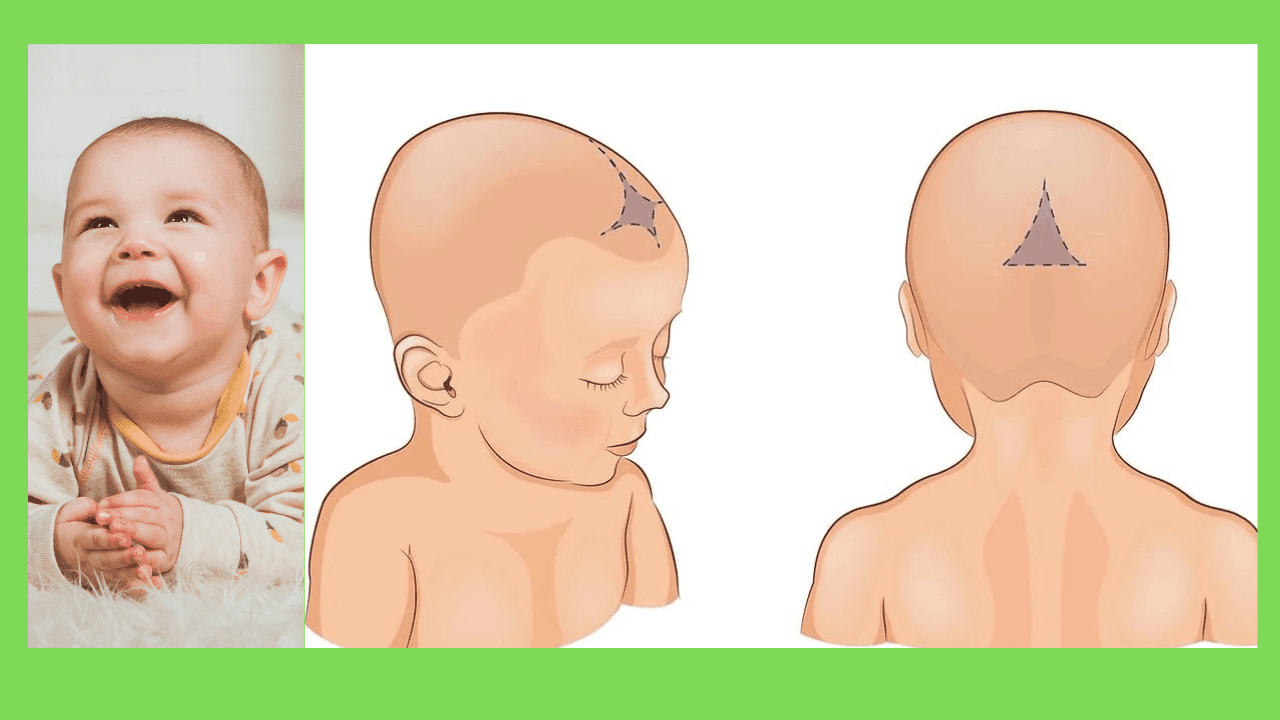Here’s an overview:
Introduction: What is the Fontanelle?
The fontanelle, also known as a “soft spot,” is a crucial part of a baby’s head anatomy. These are gaps between the cranial bones where the sutures intersect. Babies typically have two primary fontanelles:
- Anterior fontanelle: Located at the top of the head, this diamond-shaped soft spot is the largest and closes by 18 to 24 months.
- Posterior fontanelle: Found at the back of the head, this smaller, triangular soft spot usually closes by 2 to 3 months.
The presence of fontanelles allows for flexible skull growth accommodating brain development and ease during birth.
Importance of the Fontanelle in Early Development
The fontanelle plays a crucial role in a baby’s development. Key benefits include:
- Brain Growth: The fontanelle allows the baby’s brain to grow rapidly during the first year.
- Childbirth: It helps the baby’s head to compress and pass through the birth canal more easily during delivery.
- Medical Assessment: Pediatricians can assess a baby’s health by examining the fontanelle. For instance, a sunken fontanelle may indicate dehydration, while a bulging one could be a sign of increased intracranial pressure.
- Protection: Contrary to belief, while soft, the fontanelle offers protection with a tough membrane safeguarding the baby’s brain.
Anatomy of a Baby’s Skull: Understanding Fontanelles
A baby’s skull is comprised of several bones separated by sutures and fontanelles. These soft spots allow for flexibility and rapid brain growth during the early months of life. There are two main fontanelles:
- Anterior Fontanelle:
- Located at the top of the head.
- Shaped like a diamond.
- Measures approximately 2.1 cm by 2.1 cm.
- Typically closes between 12-18 months.
- Posterior Fontanelle:
- Found at the back of the head.
- Triangular shape.
- Smaller in size.
- Usually closes by 1-2 months.
Understanding these fontanelles is crucial for monitoring healthy development.
Types of Fontanelles: Anterior, Posterior, and More
Anterior Fontanelle
- Located at the top of the head.
- Usually closes between 18 to 24 months.
- Largest fontanelle and diamond-shaped.
Posterior Fontanelle
- Found at the back of the head.
- Typically closes by 2 to 3 months.
- Smaller and triangular-shaped.
Sphenoidal Fontanelles
- Positioned on the sides of the skull, near the temples.
- Closes at around 6 months.
- Small and irregularly shaped.
Mastoid Fontanelles
- Located near the base of the skull, behind the ears.
- Closes by the end of the first year.
- Irregular shape and less prominent.
These fontanelles play crucial roles in childbirth and brain growth, adding flexibility to an infant’s skull structure. Understanding their location and closure timelines aids in monitoring infant health.
When Do Fontanelles Close?
Fontanelles, commonly known as soft spots, close at different stages of a baby’s development.
- The posterior fontanelle generally closes within the first 2-3 months of life.
- The larger anterior fontanelle takes more time and typically closes between 12-18 months.
Monitoring soft spots enables healthcare providers to check infant growth and development. Delayed closure or early closure requires medical evaluation. Factors like genetics and health conditions can influence the timeline. Pediatric check-ups track these milestones and ensure overall development.
Observing the Fontanelle: What is Normal and What is Not
Normal Fontanelle Characteristics:
- Soft and Flat: A healthy fontanelle should feel soft and flat against the skull.
- Pulsation: It’s normal to observe gentle pulsation in rhythm with the baby’s heartbeat.
- Size: The anterior fontanelle is typically 1-3 centimeters in size, while the posterior is smaller or sometimes not palpable.
Signs of Concern:
- Bulging: A visibly bulging fontanelle, especially when the baby is calm, can indicate increased intracranial pressure.
- Sunken: A sunken fontanelle might suggest dehydration, necessitating prompt medical evaluation.
- Rapid Closure: Early closure of the fontanelle could signal craniosynostosis, requiring professional assessment.
Head Shapes and Fontanelles: What Parents Need to Know
Parents might notice variations in their baby’s head shape and fontanelle size. Both are usually normal and part of development. Key points include:
- Normal head shapes: Many infants are born with slightly misshapen heads due to the birth process.
- Fontanelle sizes: The anterior fontanelle is diamond-shaped and measures 1 to 3 centimeters across.
- Concern indicators:
- Bulging: May indicate increased intracranial pressure.
- Sunken: Potential dehydration.
- Delayed closure: Can signal developmental issues.
Prompt consultation with a pediatrician is vital if abnormalities are observed.
Common Myths and Misconceptions About Fontanelles
- Fontanelles Are Extremely Fragile: While fontanelles require gentle handling, the underlying protective membrane is quite tough.
- A Sunken Fontanelle Always Indicates Dehydration: Sunken fontanelles can signal dehydration, but they may also be due to other factors such as weight loss or low fluid intake.
- Bulging Fontanelles Always Signal Brain Issues: Bulging can occur during episodes of crying or laying down; it does not always indicate serious conditions.
- Fontanelles Close at a Uniform Rate: The closing rate varies. The posterior fontanelle typically closes by 2 months, while the anterior may close around 18 months.
- Touching a Fontanelle Harms the Baby: Gentle touch is safe. Pediatricians often examine fontanelles for developmental insights.
Fontanelle-Related Health Issues: Signs and Symptoms to Watch Out For
Parents must be vigilant for any unusual changes in their baby’s fontanelle. Key signs to monitor include:
- Bulging Fontanelle: Could indicate increased intracranial pressure, infections such as meningitis, or fluid buildup.
- Sunken Fontanelle: Often a sign of dehydration or malnutrition.
- Pulsating Fontanelle: A rhythmic pulsation might be seen in healthy babies, though if excessive, it warrants medical attention.
- Delayed Closure: Fontanelles usually close by 18-24 months; delays might need evaluation.
- Redness or Swelling: Signs of infection or trauma should be immediately assessed by a healthcare provider.
Caring for Your Baby’s Fontanelle
Parents should handle their baby’s fontanelle gently. Here are some tips:
- Touching: It’s safe to touch the fontanelle gently. Use a soft hand.
- Bathing: Wash the baby’s scalp with a soft cloth. Avoid rough scrubbing.
- Protecting: Ensure the baby’s head is protected. Avoid any impact or pressure.
- Temperature: Keep the baby’s head warm. Use hats in colder weather.
- Monitoring: Check for any unusual changes. Consult a pediatrician about concerns.
- Positioning: Vary the baby’s position. Prevent flat spots on the head.
Regular checks and gentle care of the fontanelle contribute to healthy development.
When to Consult a Pediatrician: Red Flags
Parents should be aware of specific red flags that indicate the need for immediate medical attention:
- Sunken Fontanelle: This may suggest dehydration, which can be serious.
- Bulging Fontanelle: Could indicate increased intracranial pressure from an infection, fluid buildup, or other issues.
- Persistent Fontanelle Pulsation: Normal, but excessive pulsation or accompanied by other symptoms may need evaluation.
- Delayed Fontanelle Closure: Typically closes by 18-24 months. Delays might signal developmental concerns.
- Unusual Soft Spots: Any additional soft spots other than the anterior and posterior fontanelles should be evaluated.
- Accompanied Symptoms: Fever, irritability, poor feeding, or lethargy coupled with fontanelle changes.
Conclusion: The Final Word on Fontanelles
Fontanelles are crucial in a baby’s skull development, providing flexibility for birth and brain growth. By understanding their functions, parents can better monitor their baby’s health. Key points include:
- Soft Spots: Fontanelles allow for brain growth and skull flexibility.
- Two Main Areas: The larger anterior fontanelle and smaller posterior fontanelle.
- Monitoring: Regular check-ups help ensure proper development.
- Signs to Watch: Sunken or bulging fontanelles may indicate health issues.
- Care Tips: Gentle handling and avoiding pressure on the soft spots.
Understanding these aspects helps parents ensure their baby’s healthy development.

